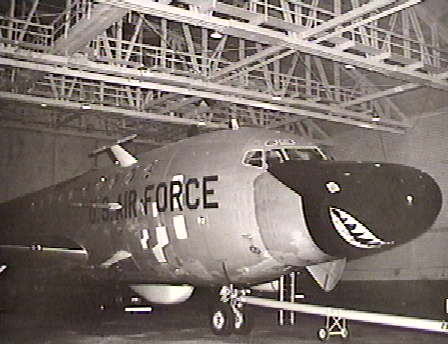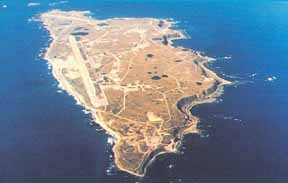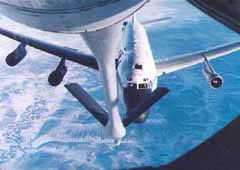A Cold-War History of Kamchatka
Because of its location on the far eastern border of Russia, Kamchatka has always had great military importance. As a result, the Peninsula was closed to all outsiders- foreigners and even most Russians were not allowed to visit the area. The United States was also keenly interested in the area, but was unable to develop much intelligence on Kamchatka until the 1960's, when improving technology allowed spy flights to probe the edges of the Soviet Union.
These flights, which operated both in Europe and in the Far East, collected communications and electronic
intelligence. One of the main missions of this program, known as Rivet Joint,  was to probe the air defense facilities of the Soviet Union, trying to collect data on the three basic types of radar- search, height-finder and fire-control- that drove the Soviet's highly sophisticated surface-to-air missle and interceptor air defense systems. The reason for this interest was simple- if America's nuclear bomber fleet should be ordered to attack the Soviet Union, or respond to a Soviet first strike, the U.S. would need to know the location and capability of every Soviet radar and anti-aircraft site to ensure that enough planes could get through. In the 1950s and 1960s, before the advent of ICBMs, nuclear-missile submarines and the like, nuclear-equipped bombers were America's main deterrent. It was in these years that American aircraft were routinely ordered to violate Soviet airspace- in some cases getting shot down- in order to provoke the Soviets to turn on their radars and thus enable American signals intelligence units to collect data.
was to probe the air defense facilities of the Soviet Union, trying to collect data on the three basic types of radar- search, height-finder and fire-control- that drove the Soviet's highly sophisticated surface-to-air missle and interceptor air defense systems. The reason for this interest was simple- if America's nuclear bomber fleet should be ordered to attack the Soviet Union, or respond to a Soviet first strike, the U.S. would need to know the location and capability of every Soviet radar and anti-aircraft site to ensure that enough planes could get through. In the 1950s and 1960s, before the advent of ICBMs, nuclear-missile submarines and the like, nuclear-equipped bombers were America's main deterrent. It was in these years that American aircraft were routinely ordered to violate Soviet airspace- in some cases getting shot down- in order to provoke the Soviets to turn on their radars and thus enable American signals intelligence units to collect data.
Rivet Joint flights near Kamchatka were launched from the remote USAF base at Shemya Island, in the far western reaches of the Aleutians. They utilized specially configured Boeing 707s with distinctive black noses and externally mounted antennas, known as RC-135s. These planes are capable of staying in the air for ten-hour stretches before needing to be refueled, and they provide American intelligence analysts with an invaluable capability to loiter near forbidden borders- such as the Soviet Union's- or in crisis areas.
in the far western reaches of the Aleutians. They utilized specially configured Boeing 707s with distinctive black noses and externally mounted antennas, known as RC-135s. These planes are capable of staying in the air for ten-hour stretches before needing to be refueled, and they provide American intelligence analysts with an invaluable capability to loiter near forbidden borders- such as the Soviet Union's- or in crisis areas.
In the early 1960's, with the development of land-based intercontinental balistic missile (ICBM) systems, Shemya took on an additional importance. RC-135 reconnaissance aircraft  were outfitted with high-resolution cameras and radar and began operating from Shemya to monitor the Soviet missile test programs. The highly classified program was code-named Cobra Ball. The impact area for many of the Soviet missiles, launched from western Russia, was on Kamchatka, just an hour's flying time from Shemya. The Cobra Ball planes carried two sophisticated camera systems: a ballistic-framing camera that can photograph the reentry of a Soviet nuclear warhead on five-inch film, and a medium-resolution system that records the wake of the reentry vehicle, an essential factor in calibrating its size. Cobra Ball also carries computerized receivers for automatically intercepting, recording, and displaying the intelligence- dealing with matters such as speed, trajectory, and rate of fuel consumption- relayed by the ICBM and its reentry vehicle to Soviet ground stations, providing data about the warhead weight, guidance systems, and accuracy of Soviet missiles.
were outfitted with high-resolution cameras and radar and began operating from Shemya to monitor the Soviet missile test programs. The highly classified program was code-named Cobra Ball. The impact area for many of the Soviet missiles, launched from western Russia, was on Kamchatka, just an hour's flying time from Shemya. The Cobra Ball planes carried two sophisticated camera systems: a ballistic-framing camera that can photograph the reentry of a Soviet nuclear warhead on five-inch film, and a medium-resolution system that records the wake of the reentry vehicle, an essential factor in calibrating its size. Cobra Ball also carries computerized receivers for automatically intercepting, recording, and displaying the intelligence- dealing with matters such as speed, trajectory, and rate of fuel consumption- relayed by the ICBM and its reentry vehicle to Soviet ground stations, providing data about the warhead weight, guidance systems, and accuracy of Soviet missiles.
 was to probe the air defense facilities of the Soviet Union, trying to collect data on the three basic types of radar- search, height-finder and fire-control- that drove the Soviet's highly sophisticated surface-to-air missle and interceptor air defense systems. The reason for this interest was simple- if America's nuclear bomber fleet should be ordered to attack the Soviet Union, or respond to a Soviet first strike, the U.S. would need to know the location and capability of every Soviet radar and anti-aircraft site to ensure that enough planes could get through. In the 1950s and 1960s, before the advent of ICBMs, nuclear-missile submarines and the like, nuclear-equipped bombers were America's main deterrent. It was in these years that American aircraft were routinely ordered to violate Soviet airspace- in some cases getting shot down- in order to provoke the Soviets to turn on their radars and thus enable American signals intelligence units to collect data.
was to probe the air defense facilities of the Soviet Union, trying to collect data on the three basic types of radar- search, height-finder and fire-control- that drove the Soviet's highly sophisticated surface-to-air missle and interceptor air defense systems. The reason for this interest was simple- if America's nuclear bomber fleet should be ordered to attack the Soviet Union, or respond to a Soviet first strike, the U.S. would need to know the location and capability of every Soviet radar and anti-aircraft site to ensure that enough planes could get through. In the 1950s and 1960s, before the advent of ICBMs, nuclear-missile submarines and the like, nuclear-equipped bombers were America's main deterrent. It was in these years that American aircraft were routinely ordered to violate Soviet airspace- in some cases getting shot down- in order to provoke the Soviets to turn on their radars and thus enable American signals intelligence units to collect data.  in the far western reaches of the Aleutians. They utilized specially configured Boeing 707s with distinctive black noses and externally mounted antennas, known as RC-135s. These planes are capable of staying in the air for ten-hour stretches before needing to be refueled, and they provide American intelligence analysts with an invaluable capability to loiter near forbidden borders- such as the Soviet Union's- or in crisis areas.
in the far western reaches of the Aleutians. They utilized specially configured Boeing 707s with distinctive black noses and externally mounted antennas, known as RC-135s. These planes are capable of staying in the air for ten-hour stretches before needing to be refueled, and they provide American intelligence analysts with an invaluable capability to loiter near forbidden borders- such as the Soviet Union's- or in crisis areas. were outfitted with high-resolution cameras and radar and began operating from Shemya to monitor the Soviet missile test programs. The highly classified program was code-named Cobra Ball. The impact area for many of the Soviet missiles, launched from western Russia, was on Kamchatka, just an hour's flying time from Shemya. The Cobra Ball planes carried two sophisticated camera systems: a ballistic-framing camera that can photograph the reentry of a Soviet nuclear warhead on five-inch film, and a medium-resolution system that records the wake of the reentry vehicle, an essential factor in calibrating its size. Cobra Ball also carries computerized receivers for automatically intercepting, recording, and displaying the intelligence- dealing with matters such as speed, trajectory, and rate of fuel consumption- relayed by the ICBM and its reentry vehicle to Soviet ground stations, providing data about the warhead weight, guidance systems, and accuracy of Soviet missiles.
were outfitted with high-resolution cameras and radar and began operating from Shemya to monitor the Soviet missile test programs. The highly classified program was code-named Cobra Ball. The impact area for many of the Soviet missiles, launched from western Russia, was on Kamchatka, just an hour's flying time from Shemya. The Cobra Ball planes carried two sophisticated camera systems: a ballistic-framing camera that can photograph the reentry of a Soviet nuclear warhead on five-inch film, and a medium-resolution system that records the wake of the reentry vehicle, an essential factor in calibrating its size. Cobra Ball also carries computerized receivers for automatically intercepting, recording, and displaying the intelligence- dealing with matters such as speed, trajectory, and rate of fuel consumption- relayed by the ICBM and its reentry vehicle to Soviet ground stations, providing data about the warhead weight, guidance systems, and accuracy of Soviet missiles.